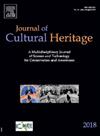Thermo-mechanical analysis for a historic statue based on a CFD-FEA coupled modeling method
IF 3.3
2区 综合性期刊
0 ARCHAEOLOGY
引用次数: 0
Abstract
The thermo-mechanical effect on historic stones, so-called “insolation weathering”, is a significant cause of stone decay. A 3D transient CFD-FEA coupled model is established to characterize and visualize the thermo-mechanical effect on a historic stone statue, while environmental factors including solar radiation, wind, and air temperature are taken into account. In this model, the CFD module is applied to perform thermal analysis between the statue and its surrounding environment, while the FEA module is applied to perform thermal and stress analyses on the statue. The established model is then applied to perform transient analysis for the statue, and effects of the environmental factors are evaluated by sensitivity analysis. Values for wind speed, solar radiation intensity, and air temperature applied in the model are chosen based on typical weather conditions in summer. Thermal results of the transient analysis show that heat is firstly radiated to surface of the statue, so the maximum temperature in the statue is recognized on the surface. The heat on the surface then partly dissipates into the air, and partly conducts to the interior. Mechanical results of the analysis show that regions with higher deformation constraints have higher maximum principal stress values, and those directly exposed to wind have higher surface pressure. The sensitivity analysis shows that higher solar radiation intensity and air temperature result in higher solid temperatures and higher maximum principal stress values. Higher wind speed results in lower solid temperature and lower maximum principal stress values. This work proves that the CFD-FEA coupled modeling method is a useful tool to quantitively investigate thermo-mechanical effects on historic stones.
基于CFD-FEA耦合建模方法的历史雕像热力分析
古石的热机械效应,即所谓的“日晒风化”,是导致石头腐烂的重要原因。在考虑太阳辐射、风和气温等环境因素的情况下,建立了三维瞬态CFD-FEA耦合模型来表征和可视化历史石像的热-力效应。在该模型中,CFD模块用于雕像与周围环境之间的热分析,FEA模块用于雕像的热分析和应力分析。将建立的模型应用于塑像的瞬态分析,并通过敏感性分析评价环境因素的影响。模式中风速、太阳辐射强度和气温的取值是根据夏季典型天气条件选择的。瞬态分析的热分析结果表明,热量首先辐射到雕像的表面,因此雕像的最高温度在表面上被识别。然后,表面的热量部分散失到空气中,部分传导到内部。力学分析结果表明,变形约束越强的区域最大主应力值越大,直接受风的区域地表压力越大。灵敏度分析表明,太阳辐射强度和气温越高,固体温度越高,最大主应力值越高。风速越大,固体温度越低,最大主应力值越低。这一工作证明了CFD-FEA耦合建模方法是定量研究古石热-力学效应的有效工具。
本文章由计算机程序翻译,如有差异,请以英文原文为准。
求助全文
约1分钟内获得全文
求助全文
来源期刊

Journal of Cultural Heritage
综合性期刊-材料科学:综合
CiteScore
6.80
自引率
9.70%
发文量
166
审稿时长
52 days
期刊介绍:
The Journal of Cultural Heritage publishes original papers which comprise previously unpublished data and present innovative methods concerning all aspects of science and technology of cultural heritage as well as interpretation and theoretical issues related to preservation.
 求助内容:
求助内容: 应助结果提醒方式:
应助结果提醒方式:


